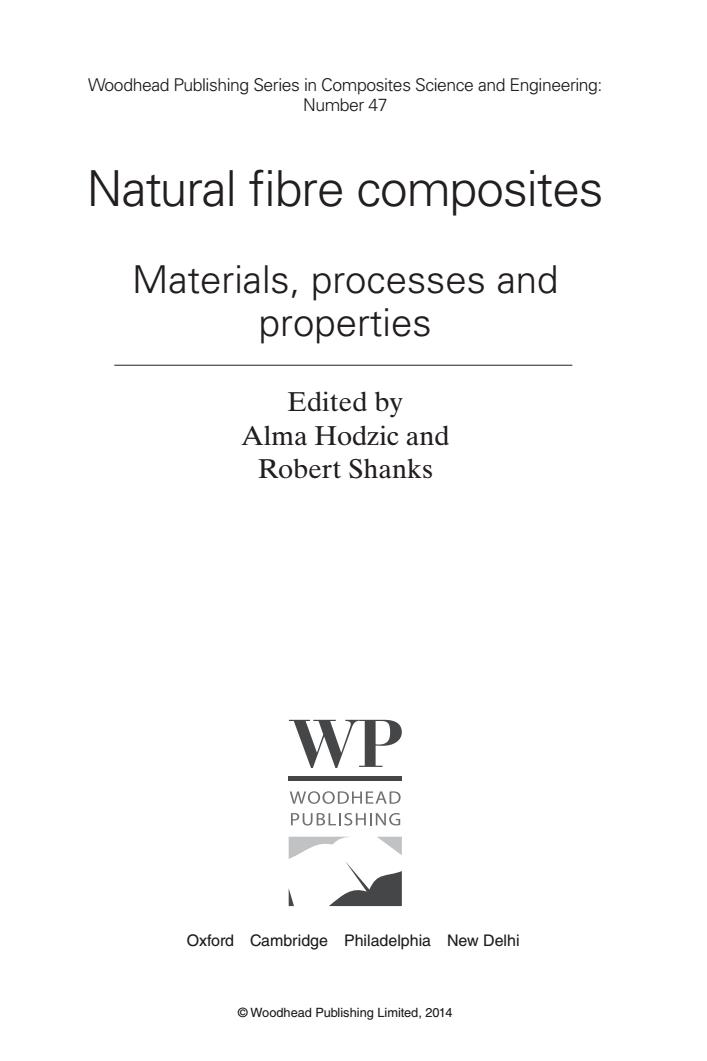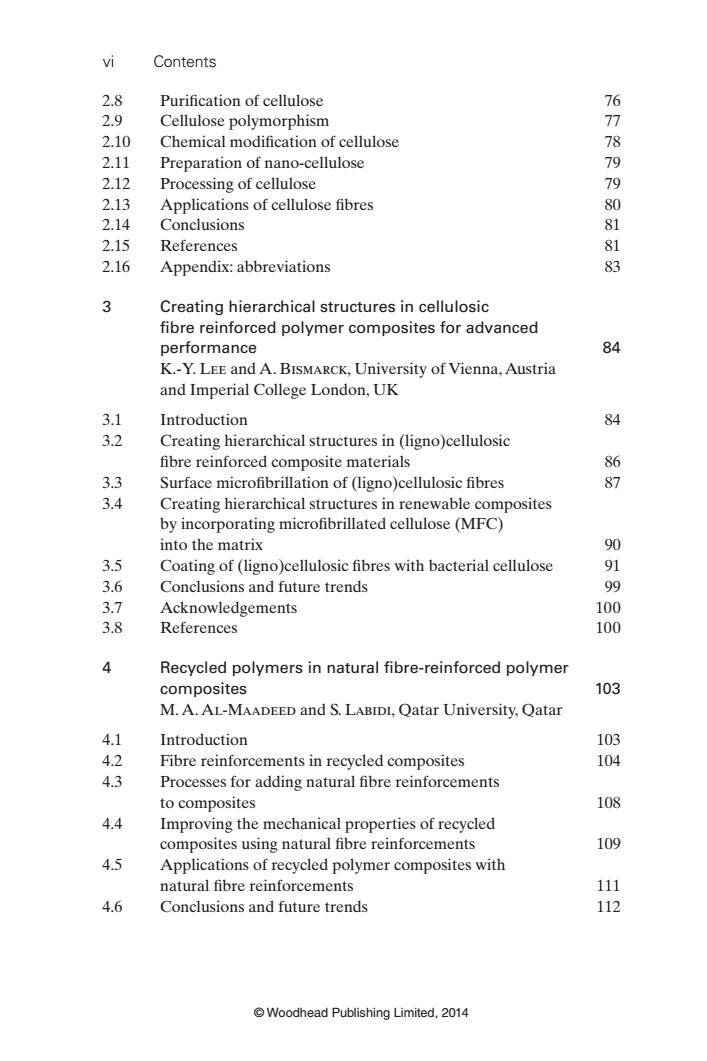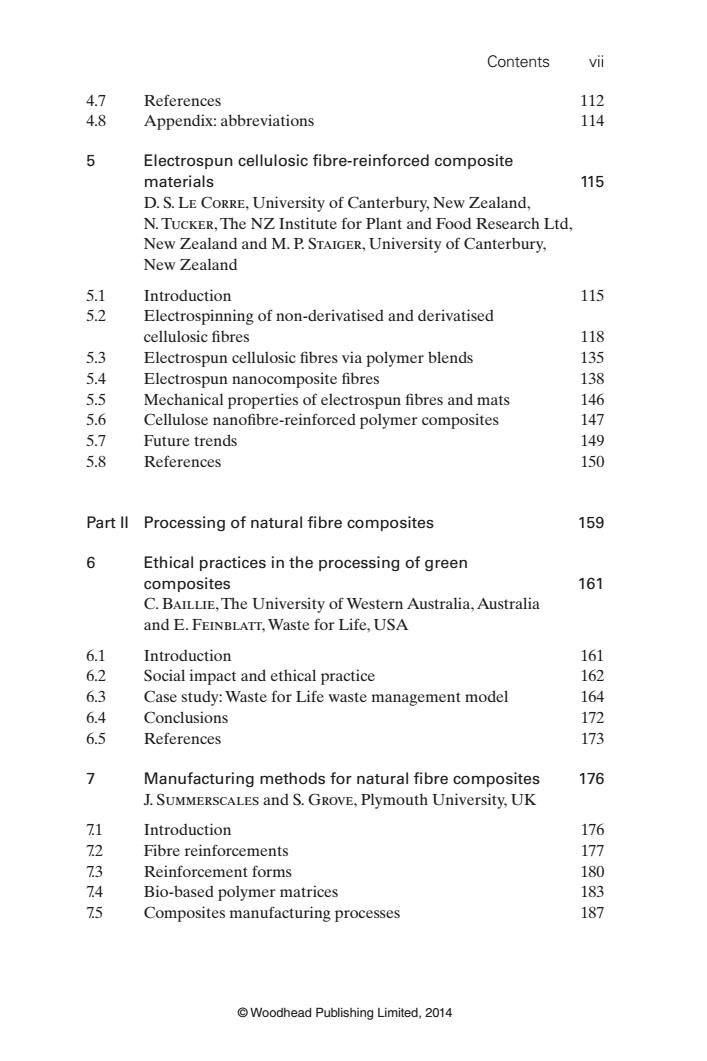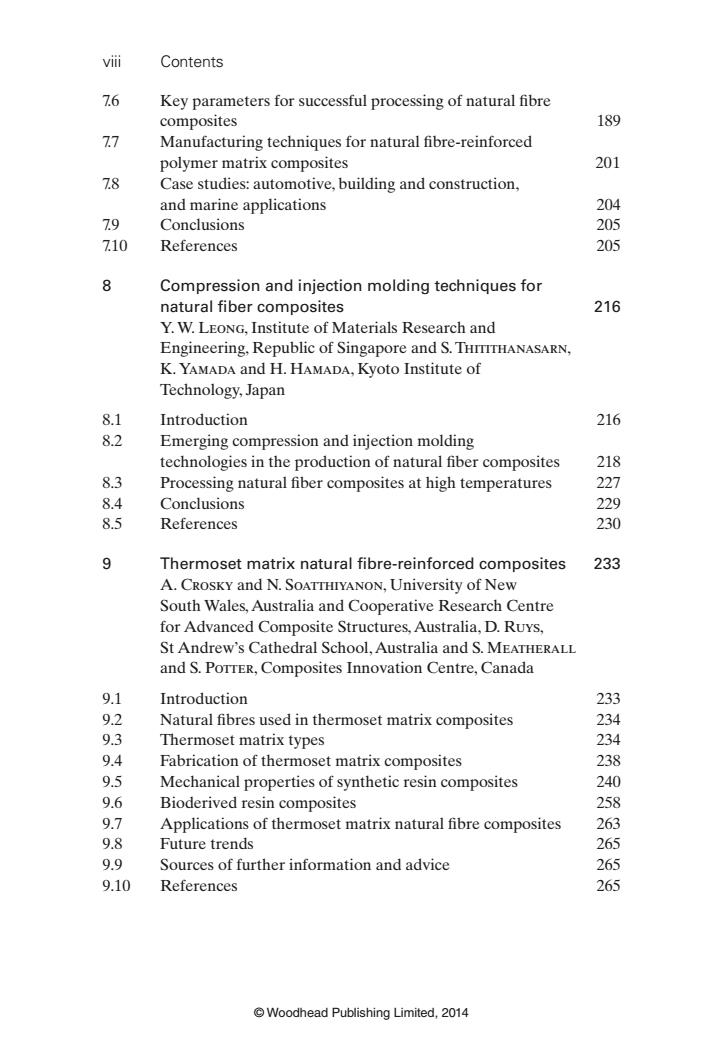
Woodhead Publishing Series in Composites Science and Engineering: Number 47 Natural fibre composites Materials,processes and properties Edited by Alma Hodzic and Robert Shanks WP WOODHEAD PUBLISHING Oxford Cambridge Philadelphia New Delhi Woodhead Publishing Limited,2014
© Woodhead Publishing Limited, 2014 Woodhead Publishing Series in Composites Science and Engineering: Number 47 Natural fi bre composites Materials, processes and properties Edited by Alma Hodzic and Robert Shanks Oxford Cambridge Philadelphia New Delhi

Contents Contributor contact details Woodhead Publishing Series in Composites Science and Engineering Part I Natural fibre reinforcements 1 Wood fibres as reinforcements in natural fibre composites:structure,properties,processing and applications 3 D.DAI and M.FAN,Brunel University,UK 1.1 Introduction 3 1.2 Wood fibres:nature and behaviour 5 1.3 Modification of wood fibres for composites 15 1.4 Matrices(binders)of wood fibre composites 22 1.5 Process techniques of wood fibre composites 27 1.6 Properties of wood fibre composites 32 1.7 Applications of wood fibre composites 34 1.8 Future trends 41 1.9 References 43 2 Chemistry and structure of cellulosic fibres as reinforcements in natural fibre composites 66 R.A.SHANKS,RMIT University,Australia 2.1 Introduction 66 2.2 Glucose monomer 67 2.3 Glucose biopolymerization 70 2.4 Cellulose structure 71 2.5 Chemical and solubility properties of cellulose 73 2.6 Sources of cellulose 75 2.7 Separation of cellulose 75 Woodhead Publishing Limited,2014
© Woodhead Publishing Limited, 2014 v Contents Contributor contact details xi Woodhead Publishing Series in Composites Science and Engineering xv Part I Natural fi bre reinforcements 1 1 Wood fi bres as reinforcements in natural fi bre composites: structure, properties, processing and applications 3 D. Dai and M. Fan, Brunel University, UK 1.1 Introduction 3 1.2 Wood fi bres: nature and behaviour 5 1.3 Modifi cation of wood fi bres for composites 15 1.4 Matrices (binders) of wood fi bre composites 22 1.5 Process techniques of wood fi bre composites 27 1.6 Properties of wood fi bre composites 32 1.7 Applications of wood fi bre composites 34 1.8 Future trends 41 1.9 References 43 2 Chemistry and structure of cellulosic fi bres as reinforcements in natural fi bre composites 66 R. A. Shanks, RMIT University, Australia 2.1 Introduction 66 2.2 Glucose monomer 67 2.3 Glucose biopolymerization 70 2.4 Cellulose structure 71 2.5 Chemical and solubility properties of cellulose 73 2.6 Sources of cellulose 75 2.7 Separation of cellulose 75

vi Contents 2.8 Purification of cellulose 76 2.9 Cellulose polymorphism 2.10 Chemical modification of cellulose 78 2.11 Preparation of nano-cellulose 79 2.12 Processing of cellulose 79 2.13 Applications of cellulose fibres 80 2.14 Conclusions 81 2.15 References 81 2.16 Appendix:abbreviations 83 3 Creating hierarchical structures in cellulosic fibre reinforced polymer composites for advanced performance 84 K.-Y.LEE and A.BISMARCK,University of Vienna,Austria and Imperial College London,UK 3.1 Introduction 84 3.2 Creating hierarchical structures in (ligno)cellulosic fibre reinforced composite materials 86 3.3 Surface microfibrillation of (ligno)cellulosic fibres 87 3.4 Creating hierarchical structures in renewable composites by incorporating microfibrillated cellulose (MFC) into the matrix 90 3.5 Coating of (ligno)cellulosic fibres with bacterial cellulose 91 3.6 Conclusions and future trends 99 3.7 Acknowledgements 100 3.8 References 100 4 Recycled polymers in natural fibre-reinforced polymer composites 103 M.A.AL-MAADEED and S.LABIDI,Qatar University,Qatar 4.1 Introduction 103 4.2 Fibre reinforcements in recycled composites 104 4.3 Processes for adding natural fibre reinforcements to composites 108 4.4 Improving the mechanical properties of recycled composites using natural fibre reinforcements 109 4.5 Applications of recycled polymer composites with natural fibre reinforcements 111 4.6 Conclusions and future trends 112 Woodhead Publishing Limited,2014
vi Contents © Woodhead Publishing Limited, 2014 2.8 Purifi cation of cellulose 76 2.9 Cellulose polymorphism 77 2.10 Chemical modifi cation of cellulose 78 2.11 Preparation of nano-cellulose 79 2.12 Processing of cellulose 79 2.13 Applications of cellulose fi bres 80 2.14 Conclusions 81 2.15 References 81 2.16 Appendix: abbreviations 83 3 Creating hierarchical structures in cellulosic fi bre reinforced polymer composites for advanced performance 84 K.-Y. Lee and A. Bismarck, University of Vienna, Austria and Imperial College London, UK 3.1 Introduction 84 3.2 Creating hierarchical structures in (ligno)cellulosic fi bre reinforced composite materials 86 3.3 Surface microfi brillation of (ligno)cellulosic fi bres 87 3.4 Creating hierarchical structures in renewable composites by incorporating microfi brillated cellulose (MFC) into the matrix 90 3.5 Coating of (ligno)cellulosic fi bres with bacterial cellulose 91 3.6 Conclusions and future trends 99 3.7 Acknowledgements 100 3.8 References 100 4 Recycled polymers in natural fi bre-reinforced polymer composites 103 M. A. Al-Maadeed and S. Labidi, Qatar University, Qatar 4.1 Introduction 103 4.2 Fibre reinforcements in recycled composites 104 4.3 Processes for adding natural fi bre reinforcements to composites 108 4.4 Improving the mechanical properties of recycled composites using natural fi bre reinforcements 109 4.5 Applications of recycled polymer composites with natural fi bre reinforcements 111 4.6 Conclusions and future trends 112

Contents vii 4.7 References 112 4.8 Appendix:abbreviations 114 5 Electrospun cellulosic fibre-reinforced composite materials 115 D.S.LE CoRRE,University of Canterbury,New Zealand, N.TUCKER,The NZ Institute for Plant and Food Research Ltd, New Zealand and M.P.STAIGER,University of Canterbury, New Zealand 5.1 Introduction 115 5.2 Electrospinning of non-derivatised and derivatised cellulosic fibres 118 5.3 Electrospun cellulosic fibres via polymer blends 135 5.4 Electrospun nanocomposite fibres 138 5.5 Mechanical properties of electrospun fibres and mats 146 5.6 Cellulose nanofibre-reinforced polymer composites 147 5.7 Future trends 149 5.8 References 150 Part ll Processing of natural fibre composites 159 6 Ethical practices in the processing of green composites 161 C.BAILLIE,The University of Western Australia,Australia and E.FEINBLATT,Waste for Life,USA 6.1 Introduction 161 6.2 Social impact and ethical practice 162 6.3 Case study:Waste for Life waste management model 164 6.4 Conclusions 172 6.5 References 173 7 Manufacturing methods for natural fibre composites 176 J.SUMMERSCALES and S.GROVE,Plymouth University,UK 71 Introduction 176 72 Fibre reinforcements 177 1.3 Reinforcement forms 180 74 Bio-based polymer matrices 183 75 Composites manufacturing processes 187 @Woodhead Publishing Limited,2014
Contents vii © Woodhead Publishing Limited, 2014 4.7 References 112 4.8 Appendix: abbreviations 114 5 Electrospun cellulosic fi bre-reinforced composite materials 115 D. S. Le Corre, University of Canterbury, New Zealand, N. Tucker, The NZ Institute for Plant and Food Research Ltd, New Zealand and M. P. Staiger, University of Canterbury, New Zealand 5.1 Introduction 115 5.2 Electrospinning of non-derivatised and derivatised cellulosic fi bres 118 5.3 Electrospun cellulosic fi bres via polymer blends 135 5.4 Electrospun nanocomposite fi bres 138 5.5 Mechanical properties of electrospun fi bres and mats 146 5.6 Cellulose nanofi bre-reinforced polymer composites 147 5.7 Future trends 149 5.8 References 150 Part II Processing of natural fi bre composites 159 6 Ethical practices in the processing of green composites 161 C. Baillie, The University of Western Australia, Australia and E. Feinblatt, Waste for Life, USA 6.1 Introduction 161 6.2 Social impact and ethical practice 162 6.3 Case study: Waste for Life waste management model 164 6.4 Conclusions 172 6.5 References 173 7 Manufacturing methods for natural fi bre composites 176 J. Summerscales and S. Grove, Plymouth University, UK 7.1 Introduction 176 7.2 Fibre reinforcements 177 7.3 Reinforcement forms 180 7.4 Bio-based polymer matrices 183 7.5 Composites manufacturing processes 187

vii Contents 7.6 Key parameters for successful processing of natural fibre composites 189 77 Manufacturing techniques for natural fibre-reinforced polymer matrix composites 201 7.8 Case studies:automotive,building and construction, and marine applications 204 79 Conclusions 205 710 References 205 8 Compression and injection molding techniques for natural fiber composites 216 Y.W.LEONG,Institute of Materials Research and Engineering,Republic of Singapore and S.THITITHANASARN, K.YAMADA and H.HAMADA,Kyoto Institute of Technology,Japan 8.1 Introduction 216 8.2 Emerging compression and injection molding technologies in the production of natural fiber composites 218 8.3 Processing natural fiber composites at high temperatures 227 8.4 Conclusions 229 8.5 References 230 9 Thermoset matrix natural fibre-reinforced composites 233 A.CROSKY and N.SOATTHIYANON,University of New South Wales,Australia and Cooperative Research Centre for Advanced Composite Structures,Australia,D.Ruys, St Andrew's Cathedral School,Australia and S.MEATHERALL and S.PorrER,Composites Innovation Centre,Canada 9.1 Introduction 233 9.2 Natural fibres used in thermoset matrix composites 234 9.3 Thermoset matrix types 234 9.4 Fabrication of thermoset matrix composites 238 9.5 Mechanical properties of synthetic resin composites 240 9.6 Bioderived resin composites 258 9.7 Applications of thermoset matrix natural fibre composites 263 9.8 Future trends 265 9.9 Sources of further information and advice 265 9.10 References 265 Woodhead Publishing Limited,2014
viii Contents © Woodhead Publishing Limited, 2014 7.6 Key parameters for successful processing of natural fi bre composites 189 7.7 Manufacturing techniques for natural fi bre-reinforced polymer matrix composites 201 7.8 Case studies: automotive, building and construction, and marine applications 204 7.9 Conclusions 205 7.10 References 205 8 Compression and injection molding techniques for natural fi ber composites 216 Y. W. Leong, Institute of Materials Research and Engineering, Republic of Singapore and S. Thitithanasarn, K. Yamada and H. Hamada, Kyoto Institute of Technology, Japan 8.1 Introduction 216 8.2 Emerging compression and injection molding technologies in the production of natural fi ber composites 218 8.3 Processing natural fi ber composites at high temperatures 227 8.4 Conclusions 229 8.5 References 230 9 Thermoset matrix natural fi bre-reinforced composites 233 A. Crosky and N. Soatthiyanon, University of New South Wales, Australia and Cooperative Research Centre for Advanced Composite Structures, Australia, D. Ruys, St Andrew’s Cathedral School, Australia and S. Meatherall and S. Potter, Composites Innovation Centre, Canada 9.1 Introduction 233 9.2 Natural fi bres used in thermoset matrix composites 234 9.3 Thermoset matrix types 234 9.4 Fabrication of thermoset matrix composites 238 9.5 Mechanical properties of synthetic resin composites 240 9.6 Bioderived resin composites 258 9.7 Applications of thermoset matrix natural fi bre composites 263 9.8 Future trends 265 9.9 Sources of further information and advice 265 9.10 References 265